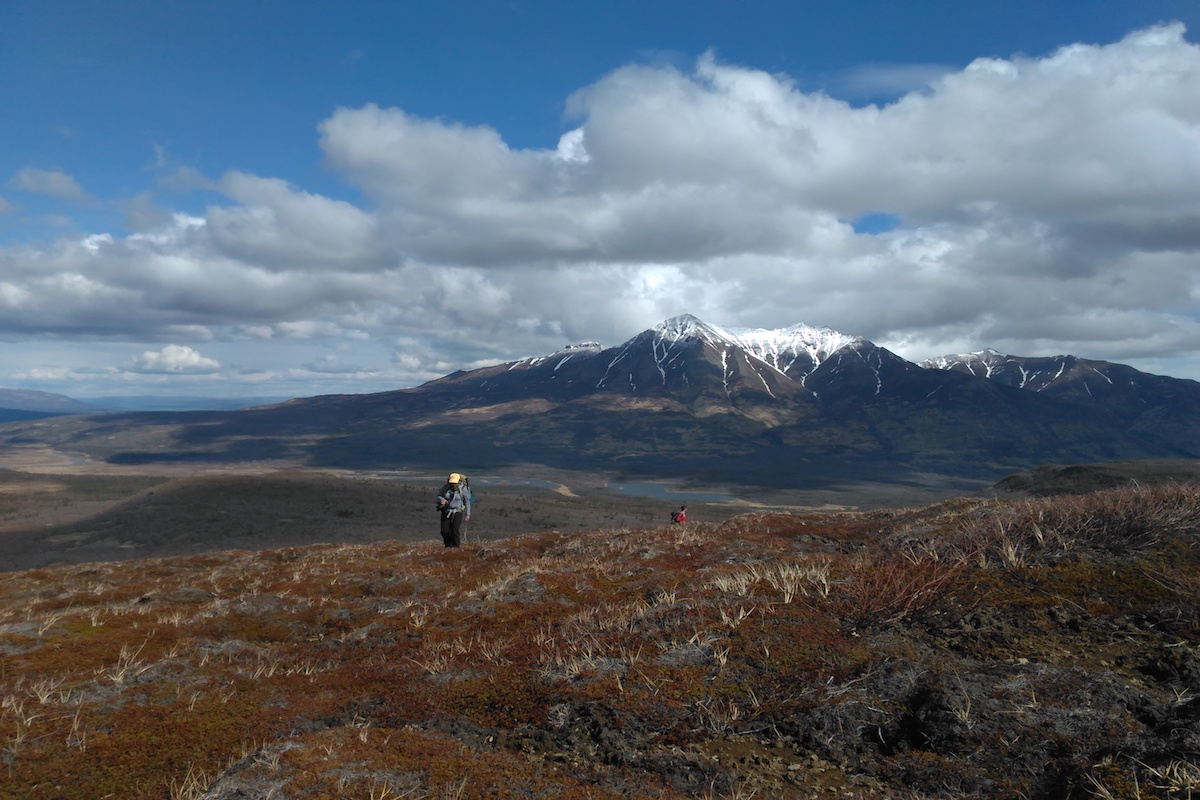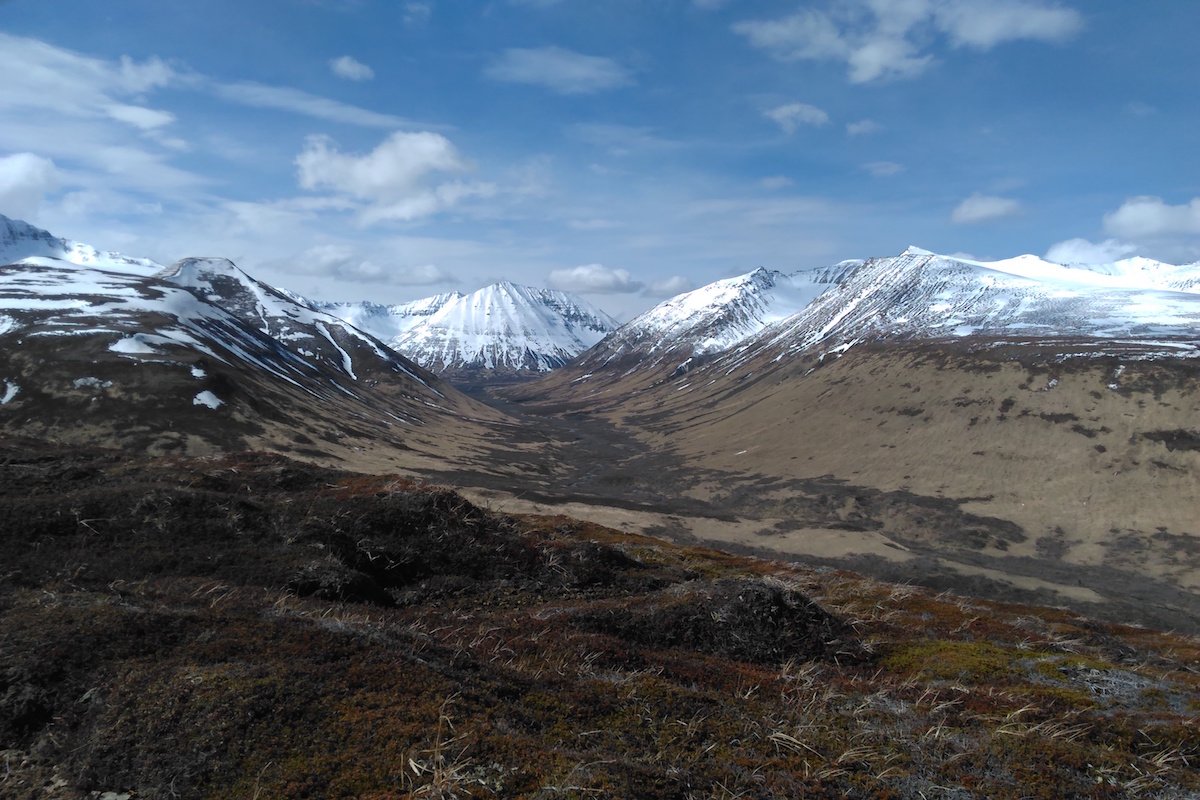Solstice Mountain, a relatively humble peak amidst craggy snowcapped giants, is also a good name. I think about it while working in a group to reach its crown. Many thoughts can race through one’s mind while ascending a steep slope. In my case, I was marveling at how my limbs and lungs could make their presence known so forcefully, while also considering how much smaller this climb had appeared at a distance.
 Photo courtesy of C. Augustson: Two hikers ascend the slope of Mt. Solstice. Mt. Katolinat and a patchwork of lakes lay to the north.
Photo courtesy of C. Augustson: Two hikers ascend the slope of Mt. Solstice. Mt. Katolinat and a patchwork of lakes lay to the north.There are no trails here, our path meandering over streams, through dense alder thickets, over water-pockmarked muskeg, and up hillsides that only ascend sharper the closer to the top one reaches. This is a true wilderness: signs of humanity are slim, but the deep tracks of moose, bear, and wolf are abundant. Mountains etch into the horizon on nearly all sides. Katolinat is the lonely but impressive sentinel to the north. The immense cone of Griggs dwarfs the Valley of Ten Thousand Smokes to the East. To the south, just out of view, lay the imposing snow-drenched profile of Mageik. These mountains carry names that hint at storied histories. Each of these peaks have loomed over the homes of past peoples that thrived near the abundant streams and lakes below. Each of these peaks have borne witness to the efforts of hardy travellers who alternately praised and cursed their hard slopes.
With what feels like herculean effort and what looks like the scuttling of a hermit crab, I scramble up to the lower reaches of the long summit of Solstice. All memories of struggles just moments ago pass quickly when I see what lay on the other side. I fashion myself to be something of a landscape connoisseur, with a palette shaped by many trips across the American West. What unfolds on the other side of Solstice could be described as “top shelf, vintage” scenery. Mountain upon jagged mountain swells beyond, their stone-green flanks cutting down into sweeping U-shaped valleys swirled with a mosaic of forest and streams. Echoes of the highlands of Tibet or the storm-tossed heart of the Alps immediately register. The effect is immediate, dizzying, and delirious.
“What are the names of those mountains?” I ask Michael, bear biologist and de facto trailblazer, as I gesture at a sweeping wall of wild windswept cliffs.
“I don’t think they have names,” Michael answers, smiling when he sees my astonishment. “A lot of mountains in Katmai are unnamed.”
 Photo courtesy of C. Augustson: The glaciated mountains and valleys to the south of Solstice are rarely visited.
Photo courtesy of C. Augustson: The glaciated mountains and valleys to the south of Solstice are rarely visited.I was thunderstruck by the concept. These peaks are as magnificent as any in the lower 48, each with its own striking contours, but they had no known name attached to them. Throughout the park are mountains that may never have one. My first reaction was one of awe: here is a place so wild that massive features are untouched by the human predilection for labels. My second reaction carried a hint of melancholy: these remarkable forms felt strangely underappreciated, no title to lend them texture and personality. The people who once lived nearby recorded no well-known stories of these peaks, and no explorer considered them worth mention. The official granter of names, the U.S. Geological Survey today is more cautious in its approach to labeling the land than it once was, in recognition of the importance of local tradition. And so they are likely to remain blank spaces on the map.

Photo courtesy of C. Augustson: In the foreground, a mosaic of tundra plants begins to grow in spring. One of the many peaks south of Solstice rises in the background.
Another reaction grows over time as I reflect that it is very likely that many landmarks throughout the park carry names from the Sugpiat-Alutiiq or Yup'ik peoples who lived within Katmai in years past. Many of those names are likely still hidden in old texts or passed along to modern descendants who keep the old names alive. Ethnographic studies like Jim Kari’s work in Denali reveals that a number of places across Alaska are drenched with many histories and names that have been obscured by the weight of Russian and U.S. colonialism, stories and traditions hundreds or thousands of years old ignored in favor of other narratives. In light of this, I wonder if past peoples, looking across the land a thousand years ago or more, ever wove narratives about these places, if there are legends lost in time that would lend meaning to these places. Perhaps many still remain.
A fourth reaction brews slower, dawning as I watch a mosaic of rain clouds pattern the land around Katolinat to the north, looking so much like a many-tentacled jellyfish floating in a sea of blue. As I sit on a ridgeline drenched with tiny pink alpine azaleas and a host of other curious forms of tundra life, I consider that it is perhaps better for some mountains to remain ever-nameless, at least officially. Names carry a tremendous amount of power. Cultures across the world affix the act of naming with spiritual weight. Consider Mount Solstice: one could just as easily name this mass Butterfly Hill, Stormclaw, or Timothy, and each would lend different shadings to how we interpret the location, each would shape how we consider it. Can a name really capture the essence of such a place? Do we pay more attention when we cannot neatly affix a place by a pin and conveniently categorize it?

Photo courtesy of C. Augustson: A hiker seeks the best route down the mountain while rain clouds, The Valley of Ten Thousand Smokes, and Mt. Griggs loom in the background.
There is a certain excitement granted to the nameless and the lands with hidden names. It renders a mountain simultaneously more mysterious and more free. Each of us is able to give our own personal title to a place, yet it remains beyond the pale of human concern. The nameless peak is perhaps at the heart of the idea of wilderness. Not even symbolism trammels here. It is the blank spaces of a map where the mind runs wildest. Just ask the medieval monks who labeled the unknown edges with sea monsters and admonitions of “Here there be dragons.”
And so I salute the peaks that remain nameless. Though they escape classification, they are a crucial part of Katmai. They lift the spirit, inspire the intellect, and dramatically shape the ecosystems out of which they tower, regardless of what we choose to call them.
